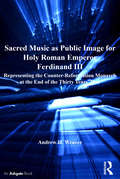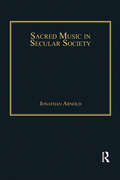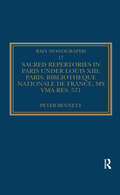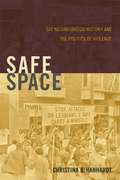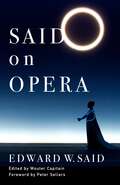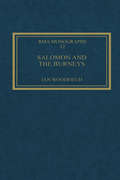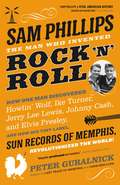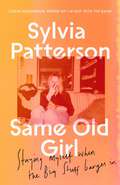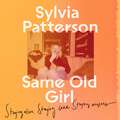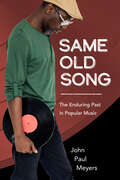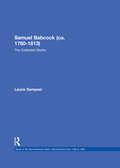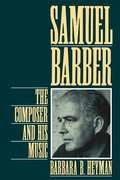- Table View
- List View
Sacred Beat: From the Heart of the Drum Circle
by Patricia Telesco Don WaterhawkThe beat is universal drumming as a way of communicating with other people, spirits, and self exists around the world and throughout time. And contemporary drumming is thriving! In the neopagan community, the most popular festivals and workshops are those that feature drumming circles. In healing centers, nursing homes, women's centers, and schools across the country, people are forming drumming circles. Sacred Beat honors and explores every aspect of drumming historical, contemporary, practical.In Part I, Telesco and Waterhawk tell the history of drums and drumming circles and the myths, superstitions, and religions that have grown up around drumming. From West Africa to Tibet, from Siberia to England, from Vietnam to Apache territory, where Fox gave the people drums along with fire come stories about drums, their invention, their use up until contemporary times. People respond almost universally and profoundly to drums to relieve stress, to communicate, to move in rhythm with the universe, to praise their gods. A comprehensive section of practical information follows, with ideas for finding a drum and other rhythmic tools that are right for your vision, caring for and decorating your instrument, drum etiquette, and elements of a good drum circle.The next section of Sacred Beat is all about drumming in groups different ways it's being done, from Native American PowWows to Goddess gatherings to community centers, and how to become a part of it. The book closes with a section on creating drumming magic all your own, with meditations, prayers, and divinations to create overall wellbeing and spiritual awareness with drums.The voice of the drum combines with the voice of the Ancestors, the voice of Spirit, and the voice of our own soul to create a powerful and transformational partnership.By working with the drum, a person can support this partnership, reach out to the community, touch the earth, and nurture their own spirit.
Sacred Music as Public Image for Holy Roman Emperor Ferdinand III: Representing the Counter-Reformation Monarch at the End of the Thirty Years' War (Catholic Christendom, 1300-1700)
by Andrew H. WeaverFerdinand III played a crucial role both in helping to end the Thirty Years' War and in re-establishing Habsburg sovereignty within his hereditary lands, and yet he remains one of the most neglected of all Habsburg emperors. The underlying premise of Sacred Music as Public Image for Holy Roman Emperor Ferdinand III is that Ferdinand's accomplishments came not through diplomacy or strong leadership but primarily through a skillful manipulation of the arts, through which he communicated important messages to his subjects and secured their allegiance to the Catholic Church. An important locus for cultural activity at court, especially as related to the Habsburgs' political power, was the Emperor's public image. Ferdinand III offers a fascinating case study in monarchical representation, for the war necessitated that he revise the image he had cultivated at the beginning of his reign, that of a powerful, victorious warrior. Weaver argues that by focusing on the patronage of sacred music (rather than the more traditional visual and theatrical means of representation), Ferdinand III was able to uphold his reputation as a pious Catholic reformer and subtly revise his triumphant martial image without sacrificing his power, while also achieving his Counter-Reformation goal of unifying his hereditary lands under the Catholic church. Drawing upon recent methodological approaches to the representation of other early modern monarchs, as well as upon the theory of confessionalization, this book places the sacred vocal music composed by imperial musicians into the rich cultural, political, and religious contexts of mid-seventeenth-century Central Europe. The book incorporates dramatic productions such as opera, oratorio, and Jesuit drama (as well as works in other media), but the primary focus is the more numerous and more frequently performed Latin-texted paraliturgical genre of the motet, which has generally not been considered by scholars as a vehicle for monarchical representation. By examining the representation of this little-studied emperor during a crucial time in European history, this book opens a window into the unique world view of the Habsburgs, allowing for a previously untold narrative of the end of the Thirty Years' War as seen through the eyes of this important ruling family.
Sacred Music in Secular Society
by Jonathan ArnoldIf music has ever given you 'a glimpse of something beyond the horizons of our materialism or our contemporary values' (James MacMillan), then you will find this book essential reading. Sacred Music in Secular Society is a new and challenging work asking why Christian sacred music is now appealing afresh to a wide and varied audience, both religious and secular. Jonathan Arnold offers unique insights as a professional singer of sacred music in liturgical and concert settings worldwide, as an ordained Anglican priest and as a senior research fellow. Blending scholarship, theological reflection and interviews with some of the greatest musicians and spiritual leaders of our day, including James MacMillan and Rowan Williams, Arnold suggests that the intrinsically theological and spiritual nature of sacred music remains an immense attraction particularly in secular society. Intended by the composer and inspired by religious intentions this theological and spiritual heart reflects our inherent need to express our humanity and search for the mystical or the transcendent. Offering a unique examination of the relationship between sacred music and secular society, this book will appeal to readers interested in contemporary spirituality, Christianity, music, worship, faith and society, whether believers or not, including theologians, musicians and sociologists.
Sacred Repertories in Paris under Louis XIII: Paris, Bibliothèque nationale de France, MS Vma rés. 571
by Peter BennettThe study of sacred music under Louis XIII (r.1610-43) has advanced little in the past hundred years. Despite some important recent contributions by the late Denise Launay and others, much of our current perception of the Latin sacred music of the period is still informed by the pioneering research undertaken by Henri Quittard in the early years of the twentieth century. Even with Quittard’s work, however, the almost complete absence of surviving sources has severely limited our understanding of this era. But by re-examining one of the seventeenth-century ’treasures’ of the Bibliothèque nationale (MS Vma rés. 571), Sacred Repertories in Paris under Louis XIII reveals that, far from being a transitional period in which little music of any interest was produced, the reign of Louis XIII witnessed a flowering of musical activity and the development of musical techniques normally associated with the reign of Louis XIV. Based on an exhaustive and innovative manuscript study, Sacred Repertories shows that Vma rés. 571 (a largely anonymous source of previously unknown provenance) was copied in Paris by the composer André Pechon, and that it preserves three previously unidentified repertories with connections to the court of Louis XIII. The repertoire of the musique de la chambre, until now considered a secular institution, shows it to have been an equal partner of the chapelle in the provision of sacred music at court. The repertoire of the royal parish church of Saint-Germain-l’Auxerrois, the only ’working’ liturgical repertory surviving from the century, illustrates musical practices at this important collegiate church. And the repertoire of the Royal Benedictine Abbey of Montmartre testifies to the richness of musical tradition in Parisian convents during a period when no other comparable music from France survives. Sacred Repertories thus transforms our understanding of the musical landscape of seventeenth-century France and provides a springboard fo
Sacred Steel: Inside an African American Steel Guitar Tradition (Music in American Life)
by Robert StoneIn this book, Robert L. Stone follows the sound of steel guitar into the music-driven Pentecostal worship of two related churches: the House of God and the Church of the Living God. A rare outsider who has gained the trust of members and musicians inside the church, Stone uses nearly two decades of research, interviews, and fieldwork to tell the story of a vibrant musical tradition that straddles sacred and secular contexts. Most often identified with country and western bands, steel guitar is almost unheard of in African American churches--except for the House of God and the Church of the Living God, where it has been part of worship since the 1930s. Sacred Steel traces the tradition through four generations of musicians and in some two hundred churches extending across the country from Florida to California, Michigan to Alabama. Presenting detailed portraits of musical pioneers such as brothers Troman and Willie Eason and contemporary masters such as Chuck Campbell, Glenn Lee, and Robert Randolph, Stone expertly outlines the fundamental tensions between sacred steel musicians and church hierarchy. In this thorough analysis of the tradition, Stone explores the function of the music in church meetings and its effect on the congregations. He also examines recent developments such as the growing number of female performers, the commercial appeal of the music, and younger musicians' controversial move of the music from the church to secular contexts.
Safe Space: Gay Neighborhood History and the Politics of Violence
by Christina B. HanhardtWinner, 2014 Lambda Literary Award in LGBT StudiesSince the 1970s, a key goal of lesbian and gay activists has been protection against street violence, especially in gay neighborhoods. During the same time, policymakers and private developers declared the containment of urban violence to be a top priority. In this important book, Christina B. Hanhardt examines how LGBT calls for "safe space" have been shaped by broader public safety initiatives that have sought solutions in policing and privatization and have had devastating effects along race and class lines.Drawing on extensive archival and ethnographic research in New York City and San Francisco, Hanhardt traces the entwined histories of LGBT activism, urban development, and U.S. policy in relation to poverty and crime over the past fifty years. She highlights the formation of a mainstream LGBT movement, as well as the very different trajectories followed by radical LGBT and queer grassroots organizations. Placing LGBT activism in the context of shifting liberal and neoliberal policies, Safe Space is a groundbreaking exploration of the contradictory legacies of the LGBT struggle for safety in the city.
Saga Boy: My Life of Blackness and Becoming
by Antonio Michael DowningA Black immigrant journeys from the Caribbean to Canada—and through multiple musical personas—in a “deeply moving” memoir “suffused with poetic prose” (Publishers Weekly, starred review).As a clever, willful boy in a tiny village in the tropical forests of Trinidad—raised by his indomitable grandmother, Miss Excelly, and her King James Bible—Antonio Michael Downing is steeped in the legacies of his scattered family, the vibrant culture of the island, and the weight of its colonial history. But after Miss Excelly’s death, everything changes. The eleven-year-old seems to fall asleep in the jungle and wake up in a blizzard: he is sent to live with his devoutly evangelical Aunt Joan in rural Canada, where they are the only Black family in a landscape starkly devoid of the warm lushness of his childhood.Isolated and longing for home, Downing begins a decades-long journey to transform himself through music and performance. A reunion with his birth parents, whom he’s known only through story, closes more doors than it opens. Instead, Downing seeks refuge in increasingly extravagant musical personalities: “Mic Dainjah,” a boisterous punk rapper; “Molasses,” a soul crooner; and, finally, an eccentric dystopian-era pop star clad in leather and gold, “John Orpheus.” In his mid-thirties, increasingly addicted to escapism, attention, and sex, Downing realizes he has become a “Saga Boy”—a Trinidadian playboy archetype—like his father and grandfather before him. When his choices land him in a jail cell, Downing must face who he has become.“Lush language and sensory details make the fascinating events of this memoir pop. An authentic, entertaining, and timely account of a creative immigrant’s experiences.” —Booklist“Downing’s elegant, engaging memoir will have particular significance to readers from the Caribbean diaspora, but it will be understood by any reader who has ever had their world suddenly upended and needed to make it whole again.” —Library Journal“A rich memoir about how far some folks have to travel just to arrive where they began.” —Minneapolis Star Tribune
Said on Opera
by Edward SaidOne of the late twentieth century’s most celebrated and influential public intellectuals, Edward W. Said was also a critic of astonishing range. This book presents his insightful and elegant analyses of four major operas—originally delivered as the Empson Lectures at Cambridge University in 1997—showcasing the power of Said’s critical acumen to unsettle canonical interpretations.In close readings of Mozart’s Così fan tutte, Beethoven’s Fidelio, Berlioz’s Les Troyens, and Wagner’s Die Meistersinger von Nürnberg, Said explores how each opera engages with the social and political questions of their own eras—and how they might speak to the present. He pays careful attention to the works’ historical context as well as the possibilities they open for contemporary reinterpretations, examining the tension between opera’s cultural prestige and its potential for subversion. Said considers the representation of national identity, class, and exoticism, and he shows how cultural and literary studies can enrich understandings of operatic texts and performance. Lucid and gracefully written, Said on Opera enlivens well-known works with fresh insights and demonstrates the breadth of Said’s contributions to cultural criticism.This book features an introduction by the editor, Wouter Capitain, who situates these essays in the context of Said’s career, and a foreword by the acclaimed opera director Peter Sellars, who offers a masterful appreciation of Said’s achievements.
Saint-Saëns and the Stage: Operas, Plays, Pageants, a Ballet and a Film (Cambridge Studies in Opera)
by Hugh MacdonaldThe stage works of Saint-Saëns range from grand open-air pageants to one-act comic operas, and include the first composed film score. Yet, with the exception of Samson et Dalila, his twelve operas have lain in the shadows since the composer's death in 1921. Widely performed in his lifetime, they vanished from the repertory - never played, never recorded - until now. With four twenty-first-century revivals as a backdrop, this timely book is the first study of Saint-Saëns's operas, demonstrating the presence of the same breadth and versatility as in his better known works. Hugh Macdonald's wide knowledge of French music in the nineteenth century gives a powerful understanding of the different conventions and expectations that governed French opera at the time. The interaction of Saint-Saëns with his contemporaries is a colourful and important part of the story.
Salomon and the Burneys: Private Patronage and a Public Career
by Ian WoodfieldJohann Peter Salomon, the celebrated violinist and impresario, made his debut in England in March 1781. History has credited Salomon with bringing Haydn to London, yet as Ian Woodfield reveals in this monograph, Salomon's introduction of the composer to the London musical scene owed as much to luck as to skilful planning. Haydn's engagement in London proved to be a much-needed uplift to Salomon's career which, as Woodfield illustrates, had been on the wane for a number of years. In addition to its reassessment of Salomon's uneven career in London during the 1780s, this book throws light on the general relationship between public and private spheres of professional music-making at the time, and on the relationship between the social and professional attributes required of musicians if they were to be successful. Nowhere are these tensions better illustrated than in the letters and journals of the Burney family, especially those of Susan Burney, which are drawn on in the book to provide a vivid picture of the fiercely competitive musical world of eighteenth-century London.
Salons, Singers and Songs: A Background to Romantic French Song 1830-1870
by David TunleyMusic! It is the great pleasure of this city, the great occupation of the drawing-rooms, which have banished politics, and which have renounced literature, from ennui. Jules Janin, An American in Paris, 1843 Afternoon and evening entertainments in the drawing rooms of the aristocracy and upper middle classes were a staple of cultural life in nineteenth-century Paris. Music was often a feature of these occasions and private salons provided important opportunities for musicians, especially singers, to develop their careers. Such recitals included excerpts from favourite operas, but also the more traditional forms of French song, the romance and its successor the m die. Drawing on extensive research into the musical press of the period, David Tunley paints a vivid portrait of the nineteenth-century Parisien salons and the performers who sang in them. Against this colourful backdrop, he discusses the development of French romantic song, with its hallmarks of simplicity and clarity of diction. Combined with Italian influences and the impression made by Schubert's songs, the French romance developed into a form with greater complexity - the m die. Salons, Singers and Songs describes this transformation and the seeds it sowed for music by later composers such as Faur Duparc and Debussy.
Sam Phillips: The Man Who Invented Rock 'n' Roll
by Peter GuralnickThe author of the critically acclaimed Elvis Presley biography Last Train to Memphis brings us the life of Sam Phillips, the visionary genius who singlehandedly steered the revolutionary path of Sun Records. The music that he shaped in his tiny Memphis studio with artists as diverse as Elvis Presley, Ike Turner, Howlin' Wolf, Jerry Lee Lewis, and Johnny Cash, introduced a sound that had never been heard before. He brought forth a singular mix of black and white voices passionately proclaiming the vitality of the American vernacular tradition while at the same time declaring, once and for all, a new, integrated musical day. With extensive interviews and firsthand personal observations extending over a 25-year period with Phillips, along with wide-ranging interviews with nearly all the legendary Sun Records artists, Guralnick gives us an ardent, unrestrained portrait of an American original as compelling in his own right as Mark Twain, Walt Whitman, or Thomas Edison.
Sam Phillips: The Man Who Invented Rock 'n' Roll
by Peter GuralnickRock 'n' roll was born in rural Alabama, 1923, in the form of Sam Phillips, the youngest son of a large family living in a remote colony called the Lovelace Community. His father had a gift for farming, which was brought to an end by the Depression. His mother picked guitar and showed the kind of forbearance that allowed her to name her son after the doctor who delivered him drunk and then had to be put to bed himself. And yet from these unprepossessing origins, in 1951 Phillips made what is widely considered to be the first rock 'n' roll record, Ike Turner and Jackie Brenston's 'Rocket 88'. Just two years later a shy eighteen-year-old kid with sideburns, fresh out of high school, wandered into his recording studio to make a record 'for his mother', secretly hoping that it might somehow get him noticed. His name was Elvis Presley. Elvis's success, and the subsequent triumph of rock 'n' roll, was initially propelled to an almost astonishing degree by a limited number of releases by Carl 'Blue Suede Shoes' Perkins, Johnny Cash and Jerry Lee Lewis - all from this tiny, one-man label. An engaging mix of biography and anecdote, Peter Guralnick's book brilliantly recreates one shining moment in the history of popular culture. And Sam Phillips was the man who brought it all about.
Sam Smith: The Biography
by Joe AllanSam Smith's debut album, In the Lonely Hour, sold four million copies and won four 2015 Grammy awards. In 2016, he won an Oscar for Best Original Song. The young, soulful singer has massive crossover appeal, with his touching honesty about loneliness, love, and his own sexuality coming through in both his music and interviews. While the media largely painted Smith as an "overnight success story," Sam Smith: The Biography shows the hard work that Smith put in for over a decade.Joe Allan is the author of 5 Seconds of Summer: The Unauthorized Biography and Chris Pratt: The Biography.
Same Old Girl: Staying alive, staying sane, staying myself
by Sylvia Patterson'There's no mistaking the writing of Sylvia Patterson' Sunday Times'One of the finest writers in the world' David QuantickHow does the big stuff in life truly change us?In late 2019, Sylvia Patterson was a celebrated pop journalist, still merrily writing about the musical greats. But with the diagnosis of a life-threatening disease, a global pandemic and the collapse of her industry, life was about to take a drastic turn.It was a misadventure that would teach her many things. The power of friendship, the shock of mortality and what happens when love is tested. How a walk in the park, a spontaneous dance and a TV hero can save your life. How your perspective can shift on everything, from work, family and music, to what truly makes you happy. And what really happens when your body, never mind your kitchen, falls apart.The follow-up to the Costa-shortlisted I'm Not with the Band, this is Sylvia's unflinching, poignant and gallows-funny odyssey through the mid-life trials we all face, as she tries to answer the big question: would it all change her, or would she stay that same old girl?
Same Old Girl: Staying alive, staying sane, staying myself
by Sylvia Patterson'There's no mistaking the writing of Sylvia Patterson' Sunday Times'One of the finest writers in the world' David QuantickHow does the big stuff in life truly change us?In late 2019, Sylvia Patterson was a celebrated pop journalist, still merrily writing about the musical greats. But with the diagnosis of a life-threatening disease, a global pandemic and the collapse of her industry, life was about to take a drastic turn.It was a misadventure that would teach her many things. The power of friendship, the shock of mortality and what happens when love is tested. How a walk in the park, a spontaneous dance and a TV hero can save your life. How your perspective can shift on everything, from work, family and music, to what truly makes you happy. And what really happens when your body, never mind your kitchen, falls apart.The follow-up to the Costa-shortlisted I'm Not with the Band, this is Sylvia's unflinching, poignant and gallows-funny odyssey through the mid-life trials we all face, as she tries to answer the big question: would it all change her, or would she stay that same old girl?
Same Old Girl: Staying alive, staying sane, staying myself
by Sylvia Patterson'There's no mistaking the writing of Sylvia Patterson' Sunday Times'One of the finest writers in the world' David QuantickHow does the big stuff in life truly change us?In late 2019, Sylvia Patterson was a celebrated pop journalist, still merrily writing about the musical greats. But with the diagnosis of a life-threatening disease, a global pandemic and the collapse of her industry, life was about to take a drastic turn.It was a misadventure that would teach her many things. The power of friendship, the shock of mortality and what happens when love is tested. How a walk in the park, a spontaneous dance and a TV hero can save your life. How your perspective can shift on everything, from work, family and music, to what truly makes you happy. And what really happens when your body, never mind your kitchen, falls apart.The follow-up to the Costa-shortlisted I'm Not with the Band, this is Sylvia's unflinching, poignant and gallows-funny odyssey through the mid-life trials we all face, as she tries to answer the big question: would it all change her, or would she stay that same old girl?
Same Old Song: The Enduring Past in Popular Music (American Made Music Series)
by John Paul MeyersPopular music and its listeners are strongly associated with newness and youth. Young people can stay up late dancing to the latest hits and use cutting-edge technology for listening to and sharing fresh music. Many young people incorporate their devotion to new artists and styles into their own developing personalities. However, if popular music is a genre meant for the youthful, what are listeners to make of the widespread sampling of music from decades-old R&B tracks, sold-out anniversary tours by aging musicians, retrospective box sets of vintage recordings, museum exhibits, and performances by current pop stars invoking music and images of the past? In Same Old Song: The Enduring Past in Popular Music, John Paul Meyers argues that these phenomena are part of what he calls “historical consciousness in popular music.” These deep relationships with the past are an important but underexamined aspect of how musicians and listeners engage with this key cultural form. In chapters ranging across the landscape of twentieth- and twenty-first-century music, Meyers finds indications of historical consciousness at work in multiple genres. Rock music canonizes its history in tribute performances and museums. Jazz and pop musicians cover tunes from the “Great American Songbook.” Hip-hop and contemporary R&B singers invoke Black popular music from the 1960s and 1970s. Examining the work of influential artists like Ella Fitzgerald, Bob Dylan, Miles Davis, Kanye West, Prince, D’Angelo, and Janelle Monáe, Meyers argues that contemporary artists’ homage to the past is key for understanding how music-lovers make meaning of popular music in the present.
Sammy Hagar's Cocktail Hits: 85 Personal Favorites from the Red Rocker
by Sammy Hagar James O. FraioliToast to the good life with the Red Rocker&’s best cocktail recipes! Sammy Hagar may be best known as the former frontman of the iconic band Van Halen. His fans know him as the Red Rocker and as the songwriter behind hits like &“I Can&’t Drive 55,&” &“Right Now,&” and &“Why Can&’t This Be Love.&” However, music is just one of his passions. Sammy is a businessman, a connoisseur of great cocktails, and the creator of Cabo Wabo Tequila, Sammy&’s Beach Bar Rums, and—along with his good friend and celebrity restaurateur Guy Fieri—a line of Santo Tequilas and Mezquila. He created Cabo Wabo Cantinas and Sammy&’s Beach Bar & Grills so people could hang out with their friends and families, have a few drinks, laugh, and enjoy the good times and unique cultures of the places he enjoys most—and the recipes in Sammy&’s Cocktail Hits: 85 Personal Favorites from the Red Rocker reflect those differences. In addition to bartending basics and cocktail foundations, chapters include: Splash of Aloha! – Hawaii&’s coolest cocktailsMas Tequila – South of the Border cocktailsSinful Signatures – VIP, Vegas–inspired cocktailsTinseltown Twists with Cleveland Pre-Funk – an original mix of Hollywood and Cleveland&’s best cocktailsEncore – More of Sammy&’s personal favorite cocktails Enjoy drinks such as the Coconut Mojito, Maui Mama, Tiki Swizzle, Blanco Gimlet, Coco Loco, Coronarita, Santo Oaxaca, Santa Paloma, Brazilian Kiss, Vojito, Strawberry Surf, and Black & Blue Lemonade, and more!
Sampling, Biting, and the Postmodern Subversion of Hip Hop
by Jim VernonDrawing on the culture’s history before and after the birth of rap music, this book argues that the values attributed to Hip Hop by ‘postmodern’ scholars stand in stark contrast with those that not only implicitly guided its aesthetic elements, but are explicitly voiced by Hip Hop’s pioneers and rap music’s most consequential artists. It argues that the structural evacuation of the voices of its founders and organic intellectuals in the postmodern theorization of Hip Hop has foreclosed the culture’s ethical values and political goals from scholarly view, undermining its unity and progress. Through a historically informed critique of the hegemonic theoretical framework in Hip Hop Studies, and a re-centering of the culture’s fundamental proscription against ‘biting,' this book articulates and defends the aesthetic and ethical values of Hip Hop against their concealment and subversion by an academic discourse that merely ‘samples’ the culture for its own reactionary ends.
Samuel Babcock: The Collected Works (Music of the New American Nation: Sacred Music from 1780 to 1820)
by Laurie J. SampselFirst Published in 1999. Routledge is an imprint of Taylor & Francis, an informa company.
Samuel Barber Remembered: A Centenary Tribute
by Peter DickinsonSamuel Barber is one of America's most popular classical composers. His widely beloved works include "Adagio for Strings" and Knoxville: Summer of 1915 . The main source for Samuel Barber Remembered: A Centenary Tribute is a panoply of vivid and eminently readable interviews by Peter Dickinson for a BBC Radio 3 documentary in 1981. The interviewees include Barber's friends, fellow composers, and performers, notably Gian Carlo Menotti, Aaron Copland, William Schuman, Virgil Thomson, soprano Leontyne Price, and pianist John Browning. The book also includes three of the very few interviews extant with Barber himself. Dickinson contributes substantial chapters on Barber's early life and on Barber's reception in England. The book has a foreword by the distinguished composer and admirer of Barber, John Corigliano. Peter Dickinson, British composer and pianist, has written or edited numerous books about twentieth-century music, including CageTalk: Dialogues with and about John Cage (University of Rochester Press) and three books published by Boydell Press: The Music of Lennox Berkeley; Copland Connotations; and Lord Berners: Composer, Writer, Painter.
Samuel Barber: A Research and Information Guide (Routledge Music Bibliographies)
by Wayne WentzelAn annotated reference guide to Barber's life, works and achievements, it will prove valuable for anyone seeking information on him.
Samuel Barber: His Life and Legacy (Music in American Life)
by Howard PollackA pivotal twentieth-century composer, Samuel Barber earned a long list of honors and accolades that included two Pulitzer Prizes for Music and the public support of conductors like Arturo Toscanini, Serge Koussevitzky, and Leonard Bernstein. Barber’s works have since become standard concert repertoire and continue to flourish across high art and popular culture. Acclaimed biographer Howard Pollack (Aaron Copland, George Gershwin) offers a multifaceted account of Barber’s life and music while placing the artist in his social and cultural milieu. Born into a musical family, Barber pursued his artistic ambitions from childhood. Pollack follows Barber’s path from his precocious youth through a career where, from the start, the composer consistently received prizes, fellowships, and other recognition. Stylistic analyses of works like the Adagio for Strings, the Violin Concerto, Knoxville: Summer of 1915 for voice and orchestra, the Piano Concerto, and the operas Vanessa and Antony and Cleopatra, stand alongside revealing accounts of the music’s commissioning, performance, reception, and legacy. Throughout, Pollack weaves in accounts of Barber’s encounters with colleagues like Aaron Copland and Francis Poulenc, performers from Eleanor Steber and Leontyne Price to Vladimir Horowitz and Van Cliburn, patrons, admirers, and a wide circle of eminent friends and acquaintances. He also provides an eloquent portrait of the composer’s decades-long relationship with the renowned opera composer Gian Carlo Menotti. Informed by new interviews and immense archival research, Samuel Barber is a long-awaited critical and personal biography of a monumental figure in twentieth-century American music.
Samuel Barber: The Composer and His Music
by Barbara B. HeymanSamuel Barber (1910-1981) was one of the most important and honored American composers of the twentieth century. Writing in a great variety of musical forms--symphonies, concertos, operas, vocal music, and chamber music--he infused his works with poetic lyricism and gave tonal language and forms new vitality. His rich legacy includes such famous compositions as the Adagio for Strings, the orchestral song Knoxville: Summer of 1915, three concertos, and his two operas, the Pulitzer Prize-winning Vanessa and Antony and Cleopatra, a commissioned work that opened the new Metropolitan Opera House at Lincoln Center. Generously documented by letters, sketchbooks, original musical manuscripts, and interviews with friends, colleagues and performers with whom he worked, this is the first book to cover Barber's entire career and all of his compositions. The biographical material on Barber is closely interspersed with a discussion of his music, displaying Barber's creative processes at work from his early student compositions to his mature masterpieces. Heyman also provides the social context in which this major composer grew: his education, how he built his career, the evolving musical tastes of American audiences, his relationship to musical giants like Serge Koussevitzky, and the role of radio in the promotion of his music. A testament to the significance of the new Romanticism, Samuel Barber stands as a model biography of an important American musical figure.

